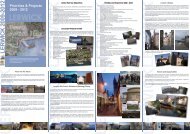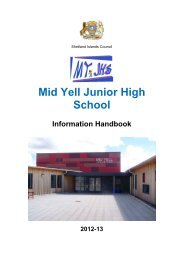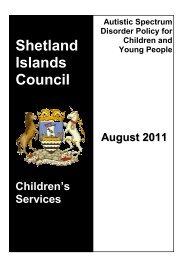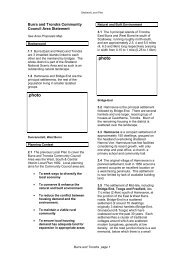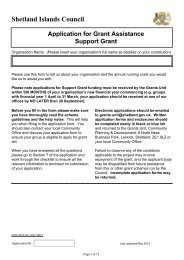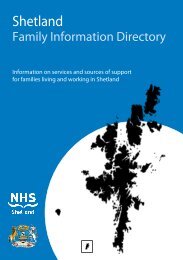Shetland Local Landscape Designation Review: Final Report
Shetland Local Landscape Designation Review: Final Report
Shetland Local Landscape Designation Review: Final Report
Create successful ePaper yourself
Turn your PDF publications into a flip-book with our unique Google optimized e-Paper software.
Candidate <strong>Local</strong> <strong>Landscape</strong> Area 11: Gletness and Skellister<br />
Location and boundaries:<br />
This headland in South Nesting is located between Cat Firth and South Nesting Bay. The<br />
landward boundary of the candidate area follows the B9075 between Cat Firth and Wester Voe<br />
of Skellister.<br />
Key characteristics:<br />
<br />
<br />
<br />
An intact, settled area, whose character has been preserved through a sympathetic<br />
approach to development<br />
An understated beauty of intricate and generally sheltered coast, rocky islands and ayres<br />
Rich in wildlife, a quiet tranquil area<br />
<strong>Designation</strong> statement:<br />
This area is an intact example of a settled coastal landscape. Although close to Lerwick, and<br />
actively settled, unlike other similar landscapes it remains largely unaffected by adverse<br />
development. It has time-depth in the relict crofting pattern of the landcover, and numerous<br />
planticrubs and other relict features. More recent development has been generally sympathetic,<br />
including the renovation of traditional buildings, and its character has not been eroded.<br />
The headland is not greatly exposed, and being located on the more sheltered east coast it is a<br />
calmer coast than elsewhere. Cat Firth to the west is enclosed on both sides. The coastline is<br />
intricate and varied, low-lying, with an often jagged rocky shoreline. The range of rocky<br />
headlands, skerries, and ayres gives the area a strong visual appeal. The Vadill of Garth is a long<br />
sinuous shingly inlet extending inland, the reverse of the gravelly ayres linking the islands off<br />
Skellister. Several such islands lie just offshore: some rugged like North isle of Gletness and Hoo<br />
Stack, others low and smoother like Little Holm. Opportunities abound to view seals and otters<br />
in and around the shallow waters. The varied coast is backed by settled pasture and lochs in the<br />
north-western part of the headland. The south-eastern areas comprise open rocky moorland,<br />
more sparsely settled, rising to Hill of the Taing (66m) near Gletness, and The Noup (72m) by<br />
Eswick. Long views from Gletness look south to Bressay and Noss. The headland of Gletness is<br />
clearly visible from the A970 as it heads north past Wadbister.<br />
Development guidelines:<br />
<br />
<br />
<br />
Development should be permitted in this area if it is at an appropriate scale, and is suitable<br />
in terms of siting and design<br />
There is potential for careful development to contribute to this landscape, as shown by<br />
sympathetic modern buildings in the area<br />
Seek to preserve the more open, remote character of the outer headlands, in contrast to<br />
the more settled area around Benston<br />
<strong>Shetland</strong> Islands <strong>Local</strong> <strong>Landscape</strong> <strong>Designation</strong> <strong>Review</strong><br />
Land Use Consultants<br />
<strong>Final</strong> <strong>Report</strong> 74 October 2011



